
PREV ARTICLE
NEXT ARTICLE
FULL ISSUE
PREV FULL ISSUE
ALAN V, WEINBERG PART II SELECTIONSHere's a selection of items I came across in the Heritage sale of the Alan V, Weinberg Collection, Part II. -Editor Lot 3316: Oak Tree Threepence
  1652 3PENCE Oak Tree Threepence, IN on Obverse, AU53 PCGS. Noe-23, W-260, Salmon 1-A, R.6. 18.0 grains. Die Alignment: 0°. Christopher Salmon enumerates nine die varieties of the Oak Tree threepence that were struck from seven obverse dies and two reverse dies, the latter re-engraved more than once for Noe-24 to 27. Salmon's obverse 1 is lettered IN MASATHVSETS with each S backward. This is the only obverse die with the word IN, and for that reason it is an important variety for type collectors. The plate coin for W-260 in the Whitman Colonial Encyclopedia, this piece is finer than two of the three Ford coins, and clearly finer than the Salmon plate coin. This is only the fourth example that we have offered during the past quarter-century. A great rarity, indeed. Super coin. -Editor To read the complete lot description, see:
Lot 3819: 1893 Columbian Exposition Gold Medal
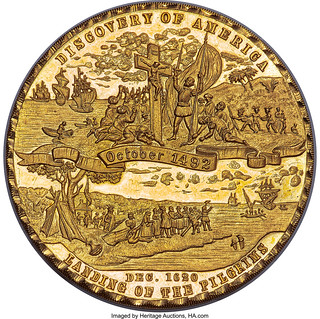 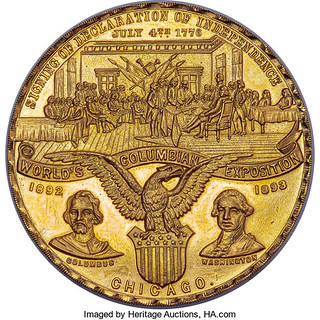 1893 Columbian Exposition Gold Medal, Eglit-36A, Similar to HK-156 and HK-157, MS63 Prooflike NGC. 171.0 grams, 58.7 mm. Reeded Edge. Maier Weinschenk (1834-1905) and William Boldenweck (1851-1922), both of Chicago, submitted design patents 20,195 and 20,196 for the obverse and reverse designs of this medal, and both were approved on October 7, 1890 for a term of 3.5 years. The original patents including drawings of the two "faces" of the medal, described in detail in the patents. From patent 20,195: "The drawing represents a front view of the design and illustrates two cardinal events in the history of America. The upper portion of the drawing represents the first cardinal event, viz: the discovery of America by Columbus. The lower portion of the drawing represents the second cardinal event, viz: the landing of the Pilgrims at Plymouth." And from patent 20,196: "The drawing represents a front view of the design. The upper portion consists of a pictorial representation of the signing of the Declaration of Independence. Immediately below this picture is a scroll extending across the face of the medal. Occupying the lower central portion of the design and partly overlapping the scroll and picture described above is an eagle surmounting a shield, and at each side of the shield and eagle is a portrait, as shown." These important medals that tell the history of America from the discovery of Christopher Columbus, to the landing of the Pilgrims, and the signing of the Declaration of Independence. A large and heavy gold medal, the design is unique in that composition, while others are known in copper or bronze, white metal, and aluminum. The Chicago firm, Boldenweck and Company, produced these medals in two sizes, 37 mm. and 58 mm. Alan V. Weinberg comments: Ex Israel Switt - the original owner of the ten 1933 double eagles, and found in the back of his Philadelphia safe. An utterly extraordinary, high-quality, heavy yellow gold (apparently 23 karat) medal that was apparently hand-finished by a Chicago jeweler who hand-scalloped the rims and finely reeded the edge. Absolutely unique with but one single auction record (Bowers & Merena) and previously unknown. One of the most impressive late 19th century medals I've ever seen. A rather busy medal design, but very impressive nonetheless. I've never seen one of these. And where else can you get a gold piece pedigreed to Izzy Switt? -Editor To read the complete lot description, see:
Lot 4439: 1790 Washington Manly Medal
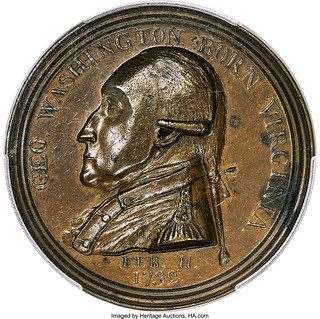 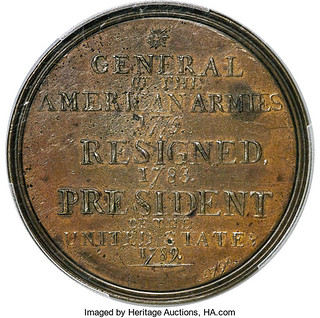 1790 Washington Manly Medal, Baker-61B, Musante GW-10, First Obverse, Bronze, MS61 Brown PCGS. This famous medal is recorded as number 17 in the 100 Greatest American Medals and Tokens by Katherine Jaeger and Q. David Bowers. They estimate that 150 to 250 of these medals are known in bronze, although few are as fine as the present example. A small number of these medals were also produced in white metal, silver, and gold. The obverse die is signed BROOKS F. on the bust truncation, while the reverse die has J. MANLY & C. 1790 inside the lower border, although Manly's name has been carefully removed from this particular example, as it has from several bronze, white metal, and silver pieces. Perhaps those that Peter Rynberg of Wilmington, Delaware sold are the pieces with Manly's name removed, or they may have been examples that Manly sold wholesale to other individuals. It is almost certain that Manly's name was removed at the time these medals were issued. Not a beautiful medal by any stretch, but early, rare and important. -Editor To read the complete lot description, see:
Lot 4442: 1857 Royal Hawaiian Agricultural Society Medal
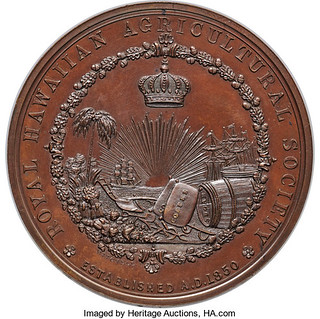  Circa 1857 Royal Hawaiian Agricultural Society Medal, Julian AM-24, Medcalf 2RM-5, Harkness HI-30. MS66 Brown NGC. Bronze, 149.4 grams, 64 mm. The obverse has a wreath enclosing the Royal Hawaiian crown and various symbols and implements of Hawaiian agriculture including cotton, sugar, a plow, two ships, and the sun and rays on the ocean horizon, with ROYAL HAWAIIAN AGRICULTURAL SOCIETY / ESTABLISHED A.D. 1850 around, and is signed by Mitchell. The reverse has a wreath enclosing a blank space with the legend PREMIUM FOR THE BEST EXHIBITED. This pristine walnut-brown medal is unawarded. Listed on page 152 of the second (1991) edition of Hawaiian Money Standard Catalog by Donald Medcalf and Ronald Russell. Julian reports that these medals were ordered in 1854, and struck through 1857. They are doubtless extremely rare. This boldly defined representative has lovely mahogany-brown surfaces with no spots or other imperfections. Francis Nalder Mitchell was a distinguished middle-19th century medalist, engraver, and die sinker who worked in Boston in the 1840s to the 1850s. He was born in Edinburgh, Scotland in 1810, and died in Scotland in 1865, having returned there a few years earlier. Among medals attributed to Mitchell are 18 different entries in the Julian reference. Mitchell engraved the award medals for the Massachusetts Charitable Mechanic Association (AM-34 through AM-41). He was selected for a die sinking award in 1850 and received the medal that he had designed. Great medal. I've never seen one of these before, either. -Editor To read the complete lot description, see:
Lot 4457: 1883 National Exposition of Railway Appliances Medal
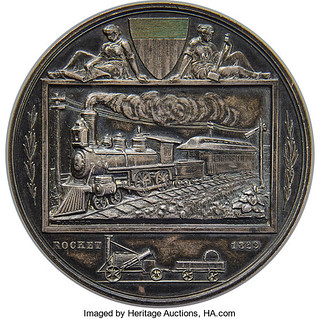 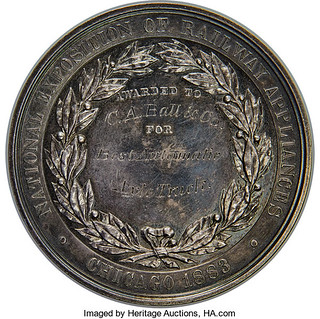 1883 National Exposition of Railway Appliances, Chicago, Silver Medal, Harkness Nat-220, MS63 NGC. 98.8 grams, 58 mm. Awarded to C.A. Ball & Co. for the best automatic axle truck. An axle truck is the assembly that includes two axles and four wheels with two axle trucks supporting each rail car. This medal is unlisted in Julian, despite being signed on the obverse by both Barber and Morgan. If it was not struck at the Mint, it would be an extremely unusual collaboration between the two engravers. These medals are doubtless extremely rare, especially when awarded as offered here. This is the first the cataloger recalls handling in any composition, and it is the first that Heritage has handled. Original records from the Exposition indicate that more silver medals were prepared than bronze or gold, although few survive. It may be the case that only a few were awarded. Great work, and double the size of a silver dollar! What's not to like about a big choo-choo medal? -Editor To read the complete lot description, see:

Wayne Homren, Editor The Numismatic Bibliomania Society is a non-profit organization promoting numismatic literature. See our web site at coinbooks.org. To submit items for publication in The E-Sylum, write to the Editor at this address: whomren@gmail.com To subscribe go to: https://my.binhost.com/lists/listinfo/esylum All Rights Reserved. NBS Home Page Contact the NBS webmaster 
|